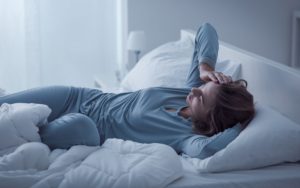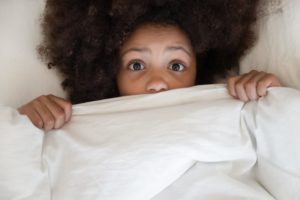Parasomnias
What they are, who they affect, their distinct types, and which treatments can help
- Parasomnias are sleep disorders involving unusual behaviors during sleep.
- Parasomnias are more common in children than adults, but genetics may play a role.
- Stress, anxiety, sleep deprivation, and certain medications can trigger parasomnias.
- Treatment approaches vary depending on the specific parasomnia and its severity.
“Parasomnia” is a catchall term for unusual behaviors that people experience prior to falling asleep, while asleep, or during the arousal period between sleep and wakefulness. These behaviors vary considerably in terms of characteristics, severity, and frequency but include sleepwalking, sleep paralysis, and night terrors.
Experts have determined that these phenomena occur when the brain transitions in and out of sleep , as well as between rapid eye movement (REM) and non-rapid eye movement (NREM) sleep stages. Parasomnias are more common in children than adults, but these behaviors have been recorded across different age groups.
Types of Parasomnia
While each parasomnia involves distinct symptoms, these behaviors can be categorized into three general groups: NREM-related, REM-related, and “other.”

NREM-Related Parasomnias
NREM-related parasomnias occur during the first three stages of the sleep cycle, which are collectively known as NREM sleep.
The most common NREM-related parasomnias are known as disorders of arousal. These parasomnias are characterized by episodes of incomplete awakening, limited responsiveness to other people attempting to intervene or redirect the sleeper, and limited awareness during the episode. Most people who experience disorders of arousal have little to no memory of their episodes.
- Confusional arousals: During a confusional arousal, a sleeper acts disoriented and may sit up and look around but does not leave the bed.
- Sleepwalking: Sleepwalking occurs when people get out of bed while still asleep but exhibit limited awareness or responsiveness to their surroundings. They may engage in other behaviors such as sorting clothes. Sleepwalking can also lead to injuries if the individual loses their balance or collides with other objects.
- Night terrors: People who experience night terrors often cry, scream, or make nonsensical sounds in their sleep and are difficult to awaken. A night terror episode can last a few minutes or up to 40 minutes .
- Sleep-related sexual abnormal behaviors: Known colloquially as “sexsomnia,” this parasomnia is characterized by sexual behaviors during sleep, such as masturbation, initiation of sexual intercourse, and sexual noises.
Another common NREM-related parasomnia is sleep-related eating disorder, which is characterized by episodes of dysfunctional eating that occur after arousal from sleep. Most people with this condition exhibit limited responsiveness during their eating episodes and have little to no memory of the events. Potential concerns include ingestion of toxic substances, injuries from cooking or preparing food, and physiological effects of unhealthy or excessive eating.
REM-Related Parasomnias
REM-related parasomnias occur during the REM stage of sleep. During normal REM sleep, the brain is particularly active, the eyes move quickly, and muscles are temporarily paralyzed . Most dreaming occurs during REM sleep.
People with REM-related parasomnias experience irregularities in the normal functions of REM sleep, such as muscle paralysis. There are several common REM-related parasomnias.
- REM sleep behavior disorder (RBD): RBD is characterized by unusual vocalizations or movements during REM sleep in an attempt to act out a dream. The behaviors tend to be associated with self-defense and may include punching, kicking, or yelling expletives. RBD is commonly seen in people with Parkinson’s disease.
- Sleep paralysis: People with sleep paralysis briefly lose the ability to move their body as they are falling asleep or upon waking. This can be paired with hallucinations or feeling suffocated. Sleep paralysis is not dangerous, but it can lead to anxiety or distress about falling asleep.
- Nightmare disorder: Everyone has unpleasant dreams every now and then. But people who experience recurrent, vivid nightmares that result in fatigue, distress, and other daytime impairments may be diagnosed with nightmare disorder. Nightmare disorder is often seen in people who have post-traumatic stress disorder (PTSD).
Other Parasomnias
The “other” category for parasomnias is dedicated to behaviors that occur during the transition between sleep or wakefulness, as well as those that can occur during both NREM and REM sleep.
- Exploding head syndrome: People with exploding head syndrome hear a loud noise or feel an exploding sensation in their head when they wake up. They may also perceive an imagined flash of light upon waking. This sensation can leave the sleeper with lingering feelings of palpitation, dread, and anxiety. Some people may experience multiple episodes per night.
- Sleep-related hallucinations: This condition can involve hypnopompic hallucinations when waking up or hypnagogic hallucinations when falling asleep. The hallucinations can include vivid images, sounds, or other sensations. The hallucinations are sometimes associated with sleep paralysis. In extreme cases, sleepers may leave their bed in an attempt to escape what they are experiencing.
- Bedwetting: Also known as sleep enuresis, bedwetting refers to involuntary urination during sleep. Bedwetting is quite common in young children. To be considered a parasomnia, it must occur in someone aged 5 or older and occur at least twice per week for three months.
If you have symptoms of one or more parasomnias, consult with your physician to learn about prevention tips and parasomnia treatment options.
References
4 Sources
-
American Academy of Sleep Medicine. (2014). The International Classification of Sleep Disorders – Third Edition (ICSD-3). Darien, IL.
https://aasm.org/ -
Zak, R., & Karippot, A. (2022, November 4). Nightmares and nightmare disorder in adults. In A. Y. Avidan (Ed.). UpToDate., Retrieved February 2, 2023, from
https://www.uptodate.com/contents/nightmares-and-nightmare-disorder-in-adults -
Schwab, R. J. (2022, May). Overview of sleep. Merck Manual Consumer Version., Retrieved February 2, 2023, from
https://www.merckmanuals.com/home/brain,-spinal-cord,-and-nerve-disorders/sleep-disorders/overview-of-sleep -
Vaughn, B. V. (2022, September 19). Approach to abnormal movements and behaviors during sleep. In A. Y. Avidan (Ed.). UpToDate., Retrieved February 2, 2023, from
https://www.uptodate.com/contents/approach-to-abnormal-movements-and-behaviors-during-sleep













